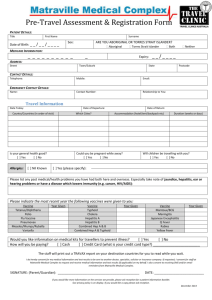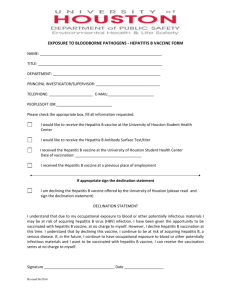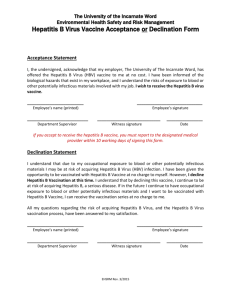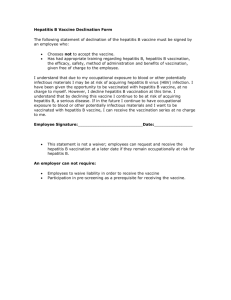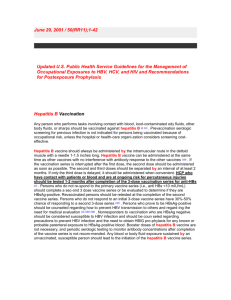Hepatitis B Vaccine Guidelines
advertisement
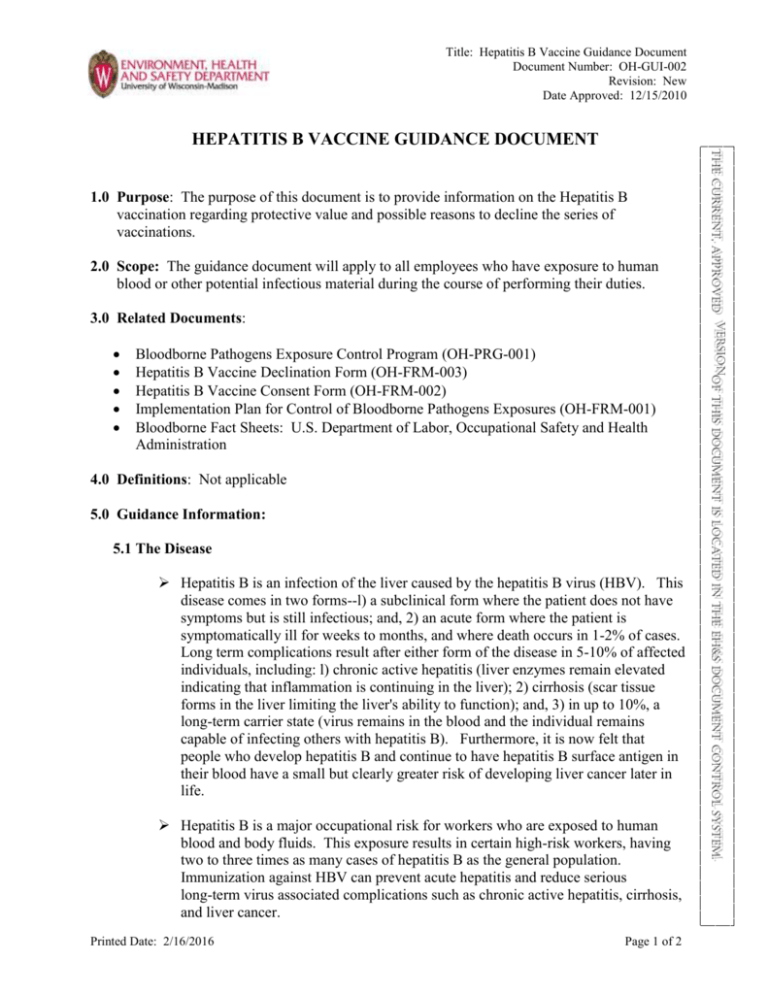
Title: Hepatitis B Vaccine Guidance Document Document Number: OH-GUI-002 Revision: New Date Approved: 12/15/2010 HEPATITIS B VACCINE GUIDANCE DOCUMENT 2.0 Scope: The guidance document will apply to all employees who have exposure to human blood or other potential infectious material during the course of performing their duties. 3.0 Related Documents: Bloodborne Pathogens Exposure Control Program (OH-PRG-001) Hepatitis B Vaccine Declination Form (OH-FRM-003) Hepatitis B Vaccine Consent Form (OH-FRM-002) Implementation Plan for Control of Bloodborne Pathogens Exposures (OH-FRM-001) Bloodborne Fact Sheets: U.S. Department of Labor, Occupational Safety and Health Administration 4.0 Definitions: Not applicable 5.0 Guidance Information: 5.1 The Disease Hepatitis B is an infection of the liver caused by the hepatitis B virus (HBV). This disease comes in two forms--l) a subclinical form where the patient does not have symptoms but is still infectious; and, 2) an acute form where the patient is symptomatically ill for weeks to months, and where death occurs in 1-2% of cases. Long term complications result after either form of the disease in 5-10% of affected individuals, including: l) chronic active hepatitis (liver enzymes remain elevated indicating that inflammation is continuing in the liver); 2) cirrhosis (scar tissue forms in the liver limiting the liver's ability to function); and, 3) in up to 10%, a long-term carrier state (virus remains in the blood and the individual remains capable of infecting others with hepatitis B). Furthermore, it is now felt that people who develop hepatitis B and continue to have hepatitis B surface antigen in their blood have a small but clearly greater risk of developing liver cancer later in life. Hepatitis B is a major occupational risk for workers who are exposed to human blood and body fluids. This exposure results in certain high-risk workers, having two to three times as many cases of hepatitis B as the general population. Immunization against HBV can prevent acute hepatitis and reduce serious long-term virus associated complications such as chronic active hepatitis, cirrhosis, and liver cancer. Printed Date: 2/16/2016 Page 1 of 2 Veeer rsssiiio on no V r o n Th heee C Cu ur rr reeen nt t,,, A Ap pp pr ro ov veeed dV offf t th hiiisss D Do oc cu um meeen nt t iiisss l lo oc ca at teeed d iiin nt th heee EEEH H& &SSS D Do oc cu um meeen nt tC Co on nt tr ro ol l SSSy yssst teeem m... T h C u r r n t A p p r o v d o t h D o c u m n t l o c a t d n t h H & D o c u m n t C o n t r o l y t m T 1.0 Purpose: The purpose of this document is to provide information on the Hepatitis B vaccination regarding protective value and possible reasons to decline the series of vaccinations. Title: Hepatitis B Vaccine Guidance Document Document Number: OH-GUI-002 Revision: New Date Approved: 12/15/2010 5.2 Recombinant DNA Hepatitis B Vaccine Recombinant hepatitis B vaccine is a non-infectious viral vaccine. It is derived from antigen produced in yeast cells and is free of human tissue or blood products. Clinical studies have established that the recombinant hepatitis B vaccines when injected into the deltoid muscle induced levels of protective immunity in greater than 90% of healthy recipients who received the recommended 3 dose regimen. 5.3 Possible Side Effects of the Vaccine Recombinant hepatitis B vaccine is generally well tolerated. No serious adverse reactions or serious hypersensitivity reactions have been reported during clinical trials. The most common side effect is soreness at the injection site. Other infrequent side effects include fatigue, headache, malaise, low grade fever, nausea, and diarrhea. 5.4 Contraindications Hypersensitivity to any component of the vaccine. Hepatitis B vaccine will not be given to pregnant or possibly pregnant women without their physician's written consent. Employees who are at risk of acquiring hepatitis B infection as a result of occupational exposure and are not protected via the vaccine will be offered Hepatitis B Immune Globulin (HBIG) to prevent infection. If you have any questions about hepatitis or hepatitis B vaccine, please ask your physician, one of the University Health Service practitioners or the Occupational Health Specialist, UW Safety Department. 6.0 Document Revision: Each time the document is revised, list the revisions in the table below. This will always be the last section of the document. Revision History Revision Number Revision Date Description of Revision 1 2 Printed Date: 2/16/2016 Page 2 of 2


